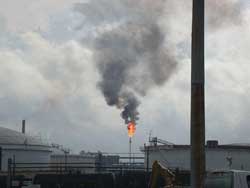Berkeleyan
CNR researcher helps communities challenge polluters
![]()
| 21 January 2004
| |
Ken Ford photo |
In New Sarpy, Louisiana, residents live near and downwind from three petrochemical plants. Each year, the refineries release tons of pollution into the air and water of the surrounding communities.
While most of the releases are permitted by law, regulations limit them (by both amount and kind) to protect public health. But nearby residents may be the first to notice when an unhealthy level of chemicals is released. The companies don’t always agree, dismissing residents’ complaints of odor and illness as attributable to other causes.
College of Natural Resources Assistant Professor Dara O’Rourke is helping residents back up their complaints with science. His recent research is intended to assess whether environmental regulation can be democratized, in order to become more transparent and effective. He examined situations with the Shell and Orion facilities in New Sarpy; with an Exxon refinery in Chalmette, Louisiana; and in the Greenpoint-Williamsburg section of Brooklyn, which has a pollution problem caused by the many trash-transfer stations for waste coming from Manhattan.
In each place, residents worked with local nonprofit groups to use various methods of monitoring to try to keep track of contaminants in their environment. Since the citizens had little or no technical expertise, the sampling ranged from low-tech to high-tech.
Sometimes residents kept written “sniffer logs” in which they recorded the time, date, and locations where they smelled odd odors, and also recorded any resulting physical symptoms, such as watery eyes, nausea, or respiratory ailments.
O’Rourke said that although the sniffer logs are low-tech, companies have been known to cut the number of releases simply because they know the releases are being tracked. Some communities have formed “bucket brigades” of residents trained to use a five-gallon paint bucket, a pump, and a sterile bag to grab air samples whenever they suspect a toxic release has occurred. [Editor’s note: Similar “brigades” have been formed in the East Bay communities of Richmond, Crockett, and Rodeo in response to frequent toxic releases from the nearby Chevron and Unocal facilities.] The samples can be analyzed for volatile organic compounds or sulfur compounds, which would be expected from a petrochemical plant. Then it can be determined if spikes in chemical levels correlate to the releases, which companies must report to environmental officials. Other testers employ expensive, handheld readers.
Before residents could do their own tests, O’Rourke says, they had no way to contest a company’s claim that even if there had been a release, it was harmless.
“It was basically the community saying, ‘It smelled bad and we felt bad,’” he says. “Now, with the bucket brigades, they can say, ‘No, it wasn’t just steam or smoke. It was methyl ethyl ketone. We know that there are things in the release that are chemicals of concern.’” Improving citizens’ knowledge and giving them an active way to participate in regulation, O’Rourke says, raises awareness and gives them a stronger voice in debates with regulators, companies, and activist groups. It also puts additional pressure on the government to do a more thorough job of monitoring and inspections, and on firms to police themselves better. In general, that leads to more complaints when environmental violations occur, and more enforcement, he says.
Giving residents an active role
But however promising it might seem to combine citizens’ efforts with governmental regulation and firms’ cooperation, there are many roadblocks. Some state environmental agencies, such as Louisiana’s, are skeptical of data from the bucket brigades. “Citizens often don’t have the time or energy to do long-term monitoring,” O’Rourke notes.
“The high-tech equipment is expensive, and the usefulness of the data varies.” Although citizens’ data have sometimes been useful in winning settlements, they have not been successfully used to prosecute a lawsuit against a company, because state-agency data are relied upon in court to determine whether a company has violated the law. Finally, even if toxic chemicals are present, linking them directly to poor health or cancer is nearly impossible.
Still, O’Rourke says, joint environmental policing has potential to hold regulators and companies more accountable while providing community members with better information and a chance to intelligently participate in the debates that shape their health. In New Sarpy, he says, residents told him “they felt like now they had some role to play, an active role — they were no longer just victims but participants in environmental protection.”
Kelly Hill is a student at the Graduate School of Journalism and an intern for the College of Natural Resources.


